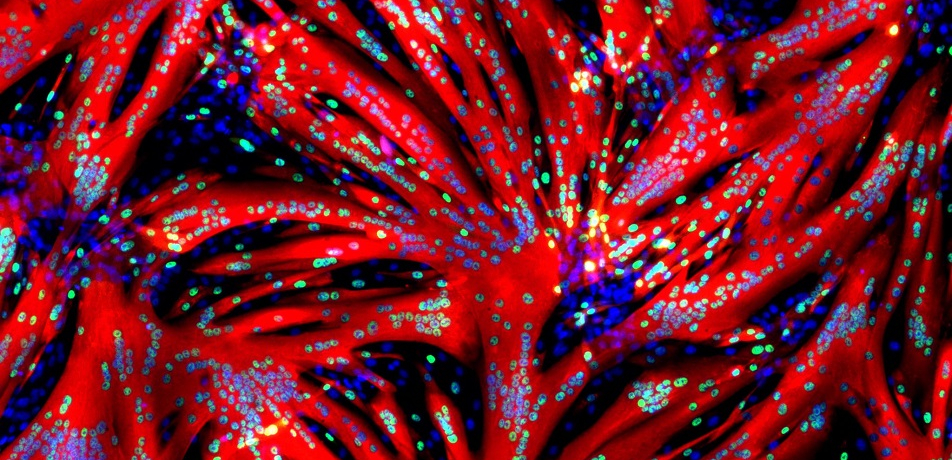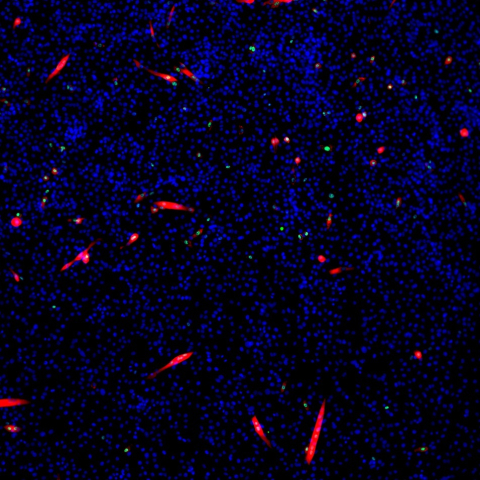Serendipity leads to sirloin
Study of muscle stem cells reveals an unexpected path to cultured meat
Briefs

The freedom to follow one’s own curiosity also means the freedom to stumble upon something you never expected to find. Prof. Eldad Tzahor and postdoc Dr. Tamar Eigler were not thinking of nutrition when they peered into a microscope examining cultured muscle stem cells. But then, they saw steak.
The cells under the lens had started fusing into tiny fibers that thickened rapidly. Within hours, these cells had created large muscle fibers resembling those in natural meat. To unravel this chain of molecular events, Prof. Tzahor and Dr. Eigler, both of the Department of Molecular Cell Biology, teamed up with Dr. Ori Avinoam of the Department of Biomolecular Sciences, who studies cell-to-cell fusion. They discovered that when particular stem cells, known as myoblasts, are exposed to a molecule that inhibits the enzyme ERK, the myoblasts differentiate and fuse, forming fibers.
This activates another enzyme, CaMKII, which triggers further, massive fusion as well as expansion.
Fibers and fusion:
Myoblasts, which are formed in the embryo, are also found on top of muscle fibers, where they are responsible for muscle repair and regeneration. Prof. Tzahor suspected that the team’s discovery about muscle growth might also have nutritional implications. “Since all muscle tissue is produced by the same biological processes, our findings were applicable both to the study of muscle regeneration and to the production of cultivated meat,” he says.
Grown in a lab from animal stem cells, cultured meat has taken off globally, as it offers a slaughter-free strategy for human nutrition that uses far less land, water, and energy than needed to raise livestock. The upshot of the Weizmann team’s research is that it has shown to accelerate the process of growing meat and muscle cells, as compared to the industry’s current standard.
Building off of their discovery, the scientists founded ProFuse Technology last year, with Dr. Eigler serving as CTO, which recently emerged as the top prizewinner at FoodTech 2021, an Israeli innovation competition.
“The company’s goal is to create better cultured meat, more quickly, at lower cost,” Prof. Tzahor says. “We believe this will lessen depen- dence on natural meat, and have a positive impact on both human and planetary health.”
Prof. Eldad Tzahor is supported by:
- Yad Abraham Research Center for Cancer Diagnostics and Therapy, which he heads
- Zuckerman STEM Leadership Program
-The Gabriella Schmidt Research Fellow Chair supports a staff scientist in Prof. Tzahor’s lab
Dr. Ori Avinoam is supported by:
- Henry Chanoch Krenter Institute for Biomedical Imaging and Genomics
- Schwartz/Reisman Collaborative Science Program
- Yeda-Sela Center for Basic Research

The surprising sight that appeared under the microscope: Muscle stem cells taken from mice before (bottom image) and following a 24-hour exposure (top image) to a molecule blocking the ERK enzyme. The mouse myoblasts had undergone rapid fusion, creating muscle fibers (red) with multiple nuclei (blue).